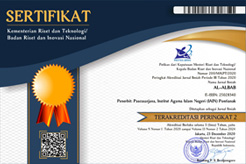State Failure and The Sunni-Shia Conflict in Sampang Madura
Abstract
Keywords
Full Text:
PDFReferences
Afdillah, M. (2013). Dari Masjid ke Panggung Politik. Yogyakarta: Thesis. Gadjah Mada University.
Ahnaf, M. I., et al. (2015). Politik Lokal dan Konflik Keagamaan. Yogyakarta: Center for Religious and Cross-Cultural Studies.
Anderson, B. (2015). Papua’s Insecurity: State Failure in the Indonesian Periphery. Hawaii: East-West Center.
Appleby, R. S. (2012). Religious Violence: The Strong, the Weak, and the Pathological. Practical Manners. Spring. Issue 5: 1-25.
Baum, G. (2001). Religion and Alienation: A Theological Reading on Sociology. Toronto: Paulist Press.
Bourdieu, P. (1998). Practical Reason on the Theory of Action. California: Stanford University Press.
Call, C. T. (2011). Beyond the ‘Failed State’: Toward Conceptual Alternatives. European Journal of International Relations. Vol. 17. No. 2: 303-326.
Eliade, M. (1987). The Sacred and the Profane: The Nature of Religion. Florida: Harcourt Inc.
Fischer, M. & Schmelzle, B.(ed.). (2009). Building Peace in the Absence of State: Challenging the Discourse of State Failure. Berlin: Berghof Research Center.
Geertz, C. 1973. The Interpretation of Culture. New York: Basic Books.
Ghani, A. et al. (2005). Closing the Sovereignty Gap: An Approach to State-Building. London: Overseas Development Institute.
Goldstone, J. A. (2008). Pathways to State Failure. Conflict Management and Peace Science 25. No. 4: 285–96. http://www.jstor.org/stable/26275148.
Haji, M. The Shia Muslims of Indonesia. The Center for the Academic Shia Studies.
Hasenclever, A., & Rittberger, V. (2000). Does Religion Make a Diference? Theoretical Approach to the Impact of Faith on Political Conflict. Millenium Journal of International Studies. Vol 29. No 3: 641-674. https://doi.org/10.1177/03058298000290031401.
Khoiri, M. A., & Chamankhah, L. (2021). Survival Mechanism of The Shia Community Post-Shia–Sunni Sampang Conflict in 2012. Al-Mada: Jurnal Agama Sosisal dan Budaya. Vol. 4 No 2: 240-251. DOI: https://doi.org/10.31538/almada.v4i2.1248.
KontraS. (2012). Laporan Investigasi dan Pemantauan Kasus Syi’ah Sampang. Surabaya: Laporan Penelitian.
Krasner, S. D., & Pascual, C. (2005). Addressing State Failure. Foreign Affairs 84. No. 4: 153–63. https://doi.org/10.2307/20034427.
Kung, H. (1991). Global Responsibility: In Search of a New World Ethic. New York: Crossroad.
Mahbub, S. (2018). Konflik dan Kekerasan Sunni-Syiah Sampang Prespektif Kultur Kekerasan dan Hak Asasi Manusia. Voice Justisia: Jurnal Hukum dan Keadilan. Volume 2. Nomor 1. Maret: 92-101.
Miichi, K., & Kayane, Y. (2019). The Politics of Religious Pluralism in Indonesia: The Shi’a Response to the Sampang Incidents of 2011–12. TRaNS: Trans-Regional and-National Studies of Southeast Asia: 1–14. doi:10.1017/trn.2019.12.
Pamungkas, C. (2018). Mencari Bentuk Rekonsiliasi Intra-Agama: Analisis terhadap Pengungsi Syiah Sampang dan Ahmadiyah Mataram. Epsiteme: Jurnal Pengembangan Ilmu Keislaman, Vol 13, No 1: 113-147. https://doi.org/10.21274/epis.2018.13.1.113-147.
Satriani, S., et al. (2019). Policy Brief: Memulihkan Hak Pengungsi Ahmadiyah dan Syiah. Setara Institute for Democracy and Peace.
Wanandi, J. (2002). Indonesia: A Failed State? The Washington Quarterly, 25:3: 135-146. http://dx.doi.org/10.1162/01636600260046299
Yaqin, N. A. (2020). Menagih Hak Beragama Muslim Ahmadiyah dan Syiah Sampang dalam Perspektif Nalar Maqâṣidî. Religi: Jurnal Studi Agama-agama. Vol. 16. No. 2: 208-227. https://doi.org/10.14421/rejusta.2020.1602-05.
INTERNET SOURCES:
http://daerah.sindonews.com/read/670816/23/pengungsi-sampang-akan-direlokasi-sementara-ke-rusunawa-1346996624 (accessed November 21, 2021).
http://www.amnesty.org.au/news/comments/34816/ (accessed November 21, 2021).
http://www.hidayatullah.com/kolom/catatan-akhir-pekan/read/2012/09/01/3822/kisah-tajul-muluk-dari-sampang.html (accessed November 21, 2021).
http://www.koranmadura.com/2013/09/30/deklarasi-syiah-menyimpang/ (accessed November 21, 2021).
http://www.theguardian.com/world/2012/jul/12/indonesia-jails-shia-cleric-blasphemy (accessed November 21, 2021).
https://news.detik.com/bbc-world/d-5242909/pengungsi-syiah-sampang-dibaiat-jadi-suni-di-tengah-keinginan-pulang-kampung (accessed November 21, 2021).
https://www.bbc.com/indonesia/indonesia-54550918 (accessed November 21, 2021).
https://www.voaindonesia.com/a/serangan-atas-kelompok-syiah-di-sampang-tuai-kecaman/1496881.html. (accessed November 19, 2021).
https://news.detik.com/bbc-world/d-5242909/pengungsi-syiah-sampang-dibaiat-jadi-suni-di-tengah-keinginan-pulang-kampung (accessed November 11, 2021).
https://yapibangil.org/yayasan/ (accessed November 21, 2021).
https://www.state.gov/reports/2020-report-on-international-religious-freedom/indonesia/ (accessed November 19, 2021).
Article Metrics
 Abstract views: 3128
Abstract views: 3128
 PDF views: 1503
PDF views: 1503











